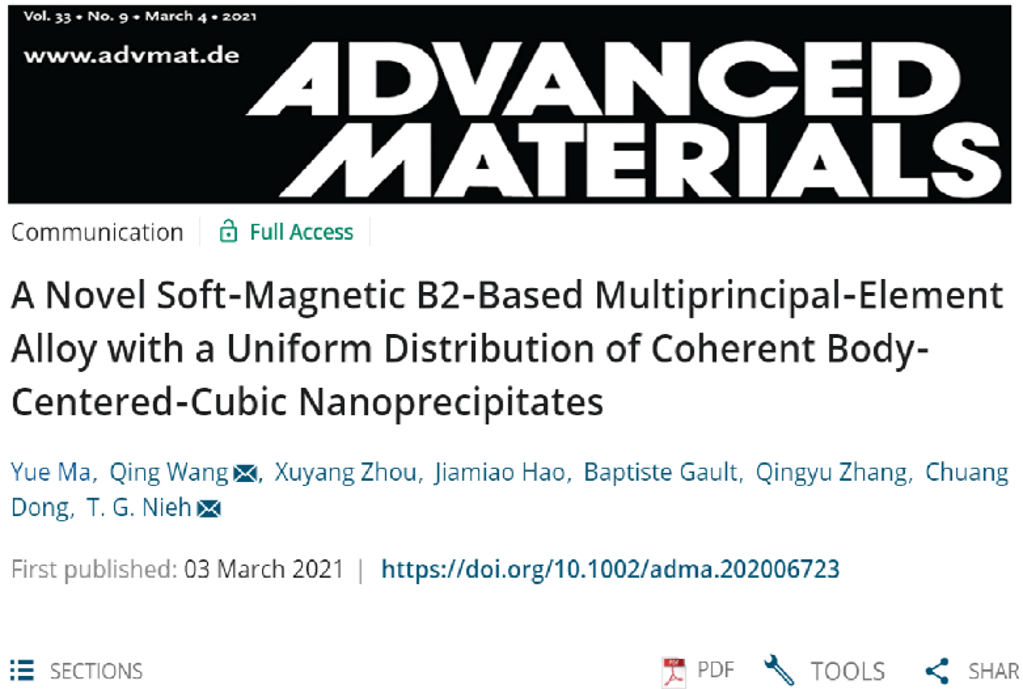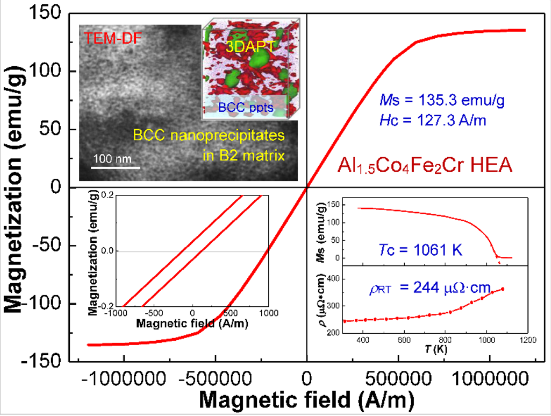Date:Mar 11, 2021
Prof. Wang Qing and her team members from School of Materials Science and Engineering, DUT, have made a breakthrough in the research of soft- magnetic properties of high-performance high entropy alloys, which achieved the structural-functional integration of material design. The research work entitled A novel soft-magnetic B2-based multi-principal-element alloy with a uniform distribution of coherent body-centered-cubic nanoprecipitates was published in Advanced Materials (IF=27.398), a top journal in the field of materials science.

Multiprincipal‐element alloys (MPEAs), including high‐entropy alloys, are a new class of materials whose thermodynamical properties are mainly driven by configuration entropy, rather than enthalpy in the traditional alloys, especially at high temperatures. Herein, the design of a novel soft‐magnetic nonequiatomic, quaternary MPEA is described, via tuning its chemical composition to deliberately manipulate its microstructure, such that it contains ultrafine ferromagnetic body‐centered‐cubic (BCC) coherent nanoprecipitates (3–7 nm) uniformly distributed in a B2‐phase matrix. The new alloy Al1.5Co4Fe2Cr exhibits high saturation magnetization (MS= 135.3 emu g‐1), low coercivity (HC= 127.3 A m‐1), high Curie temperature (TC= 1061 K), and high electrical resistivity (ρ = 244 μΩ cm), promising for soft magnets. More importantly, these prominent soft‐magnetic properties are observed to be retained even after the alloy is thermally exposed at 873 K for 555 h, apparently attributable to the excellent stability of the coherent microstructure. The versatility of the magnetic properties of this new alloy is discussed in light of the microstructural change induced by tuning the chemical composition, and the enhanced performance of the alloy is compared directly with that of the traditional soft‐magnetic alloys. The perspective is also addressed to design high‐performance soft‐magnetic alloys for high‐temperature applications.

Advanced Materials, a comprehensive journal subordinated to Wiley, has a 2019 journal impact factor of 27.398. It is a top journal in the disciplines of engineering and computing, as well as in the fields of materials and chemistry. Moreover, its H5 factor ranking is in the second place of non-review journals.
The first author of the paper is Ma Yue, a PhD student from School of Materials Science and Engineering, and the corresponding authors are Prof. Wang Qing from DUT and Prof. T. G. Nieh from The University of Tennessee, USA. Prof. Zhang Qingyu from School of Physics and Prof. Dong Chuang from School of Materials Science and Engineering participated in the discussion of the ideas of the paper, and Dr. Zhou Xuyang and Dr. B. Gault from Max Planck Institute, Germany, helped in the 3D atom probe experiments. Meanwhile, the National Natural Science Foundation of China (NSFC), the “13th Five-Year” National Key R&D Program, and the Basic Research Program of Key Universities have provided funding for this research work.
Link to the paper: